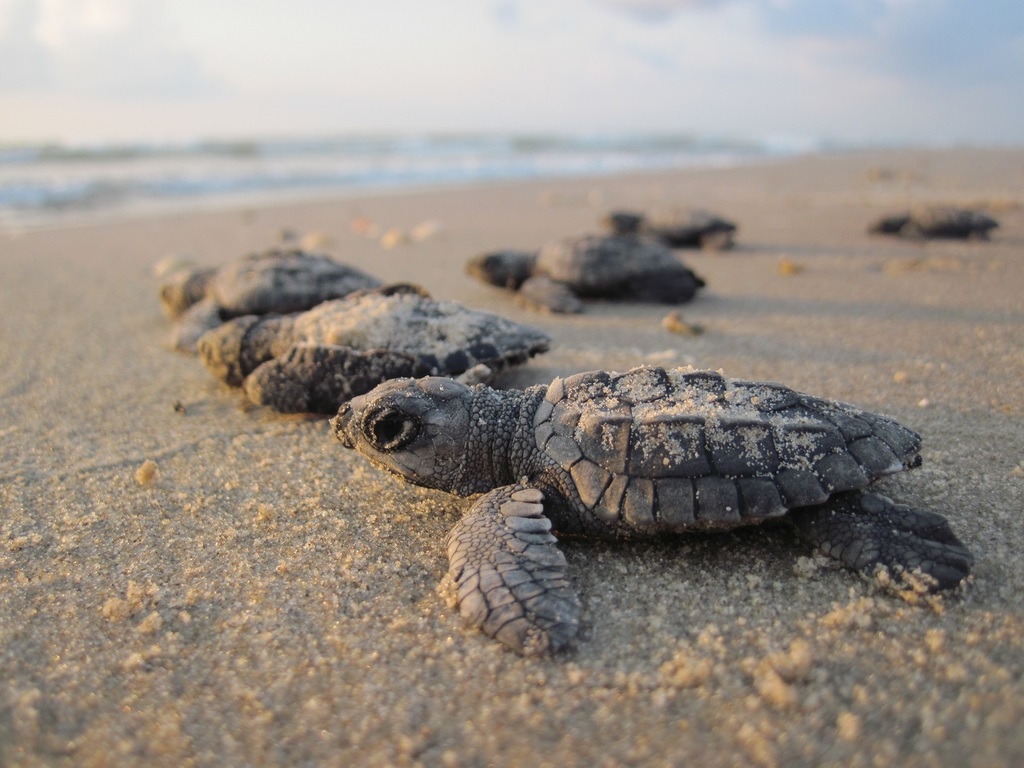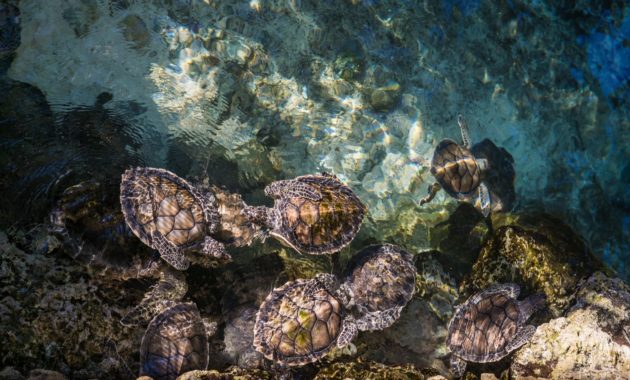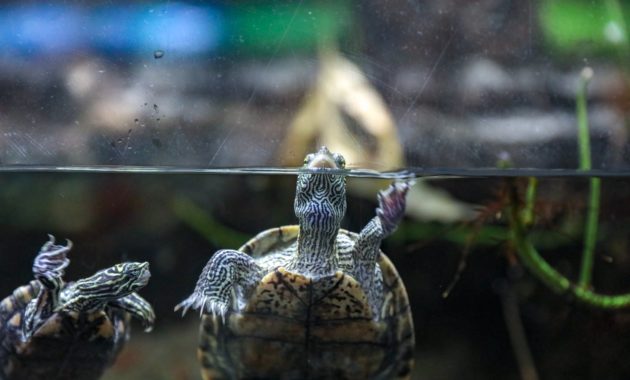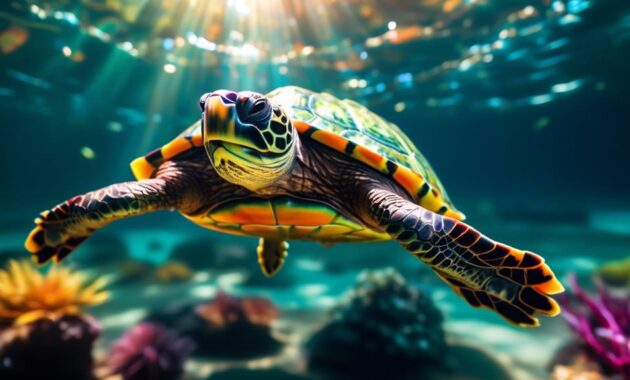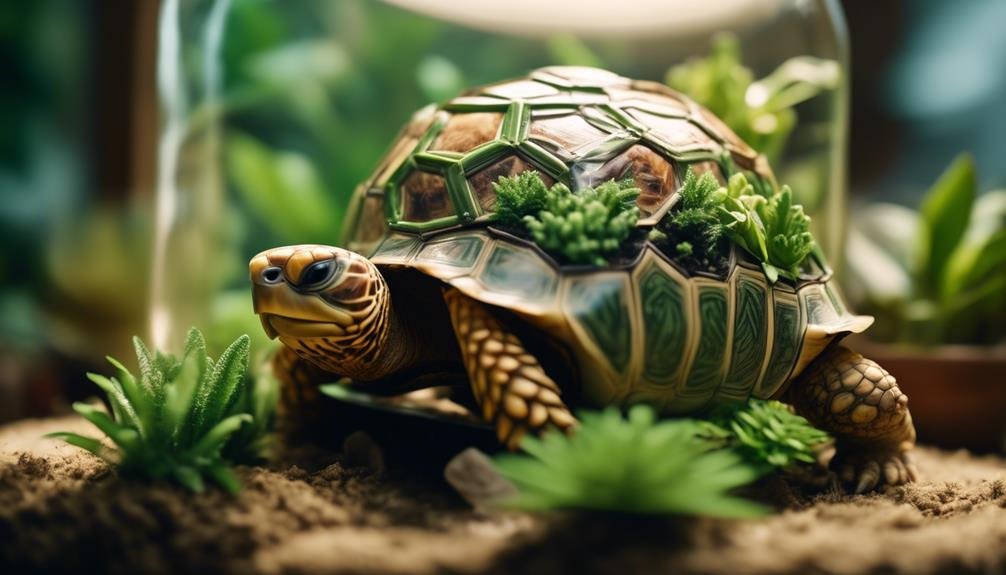
They say that good things come in small packages, and the Russian Tortoise is no exception. Step into the enchanting world of these captivating creatures and prepare to be amazed.
With their unique characteristics, longevity, and intriguing habitat, these tortoises are a fascinating species worth getting to know. But that's not all. Stay tuned as we unravel their secrets, uncover their vibrant colors, and unveil the key to providing them with the best care.
Get ready to embark on a journey like no other, where you'll discover why the Russian Tortoise is truly a treasure worth exploring.
Key Takeaways
- Russian Tortoises have a lifespan of 50-100 years and prefer cold winters and hot summers.
- They thrive in hilly or rocky areas near vegetation and grass, and they burrow and modify animal burrows for shelter.
- Russian Tortoises have a low protein, high fiber diet consisting of leafy greens, hays, grasses, flowers, and weeds.
- They require a dry, warm environment with a humidity level of around 60%, a basking area temperature of 90-95F, and a full-spectrum fluorescent bulb for UVB rays.
Size, Lifespan, and Habitat
Russian Tortoises are small, fascinating creatures with a lifespan of 50-100 years, and they thrive in terrestrial habitats. These tortoises have a small size, with their length varying. They prefer cold winters and hot summers and are usually found in hilly or rocky areas near vegetation and grass. Russian Tortoises burrow and modify animal burrows to create shelters for themselves.
Their diet consists of leafy greens, hays, grasses, flowers, and weeds. They require a low protein, high fiber diet to stay healthy. Native to dry desert environments, Russian Tortoises are found in Iran, Afghanistan, Kazakhstan, Uzbekistan, China, Russia, and Pakistan.
Their appearance is stocky, with a rounded and oval carapace and a rigid plastron without a movable hinge. Their colors range from almost black to bright yellow, with most being brown to olive.
Food and Diet
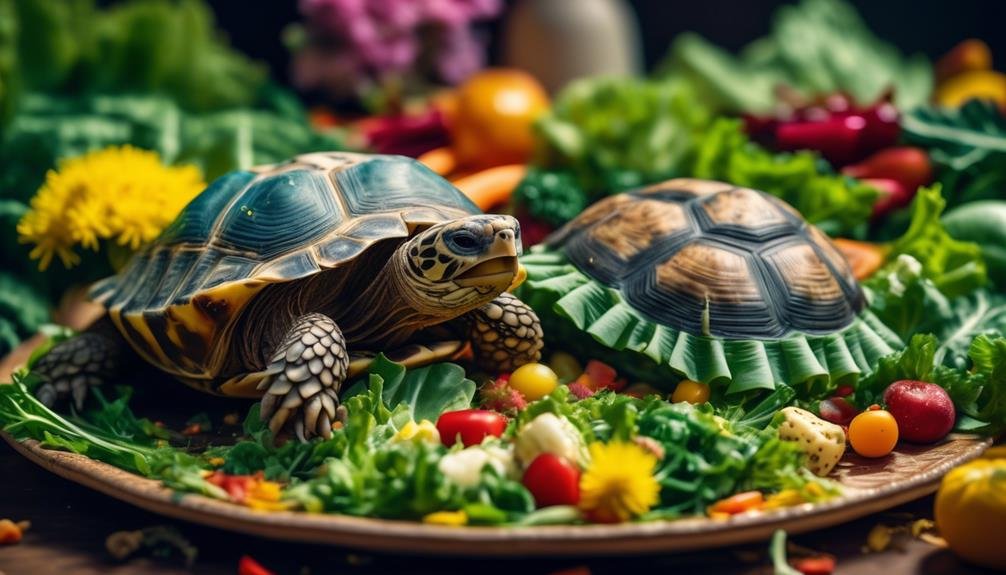
What do Russian Tortoises eat to stay healthy and thrive in their environment? Russian Tortoises have a specific diet that consists mainly of leafy greens, hays, grasses, flowers, and weeds. They require a low protein, high fiber diet to maintain their health. It is important to feed them a diet that is low in protein, rich in calcium, and high in fiber. To engage the audience, here is a table showcasing some examples of the foods that Russian Tortoises can eat:
| Food | Description |
|---|---|
| Leafy greens | Spinach, kale, dandelion greens |
| Hays | Timothy hay, alfalfa hay |
| Grasses | Bermuda grass, ryegrass |
| Flowers | Hibiscus, marigold |
| Weeds | Plantain, chickweed |
Native Habitat
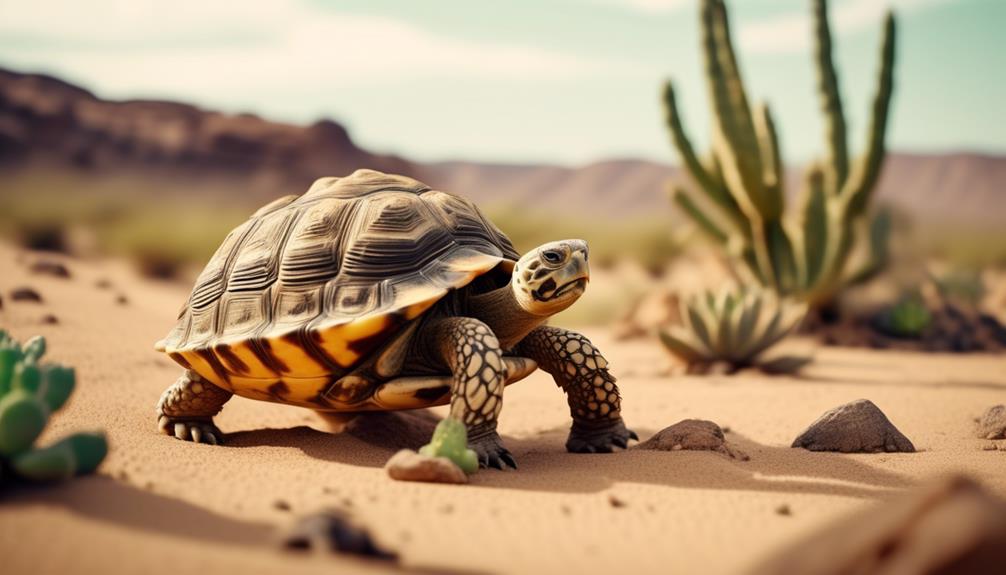
The native habitat of Russian Tortoises spans across a variety of dry, desert environments in Iran, Afghanistan, Kazakhstan, Uzbekistan, China, Russia, and Pakistan. These tortoises thrive in hilly or rocky areas near vegetation and grass. They prefer cold winters and hot summers, and are known to burrow and modify animal burrows for shelter.
In their natural habitat, they've adapted to survive with a diet of leafy greens, hays, grasses, flowers, and weeds. The Russian Tortoise is well-suited for these arid environments, with its stocky appearance, rounded and oval carapace, and rigid plastron. They come in a range of colors, from almost black to bright yellow, with most being brown to olive.
Understanding their native habitat is crucial for providing the right care and environment for these fascinating creatures.
Description and Colors
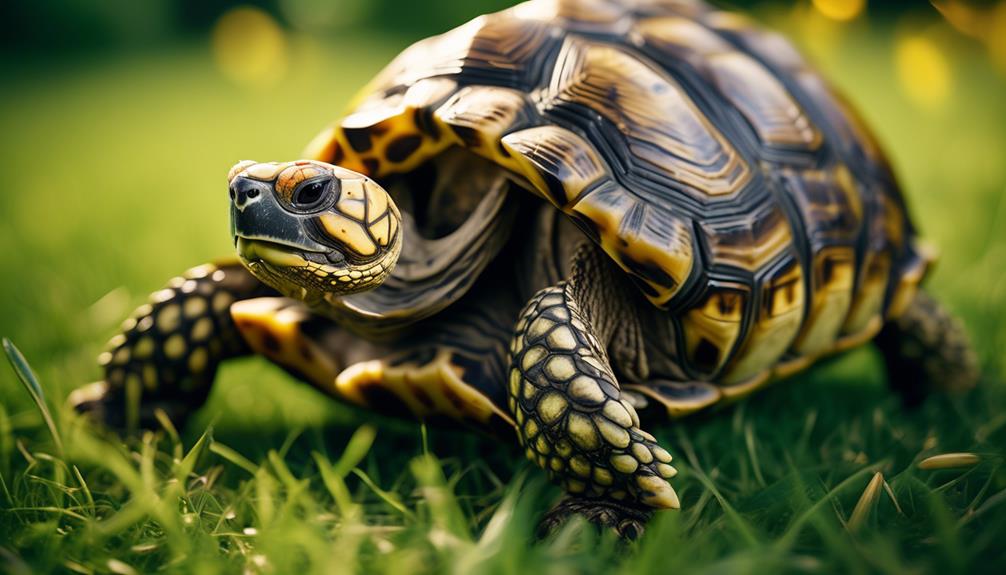
As we delve into the fascinating world of Russian Tortoises, let's now turn our attention to their unique description and captivating range of colors.
These remarkable creatures possess a stocky appearance, with a rounded and oval carapace that sets them apart. Their rigid plastron lacks a movable hinge, and they've four claws on each foot, with a terminal claw on the tail.
But what truly makes them stand out is their stunning array of colors. From almost black to bright yellow, Russian Tortoises display a mesmerizing palette, with most individuals showcasing shades of brown to olive.
Whether you encounter a tortoise with bold and vibrant hues or a more subtle and earthy tone, their colors are sure to leave you in awe.
Care Requirements and Behavior
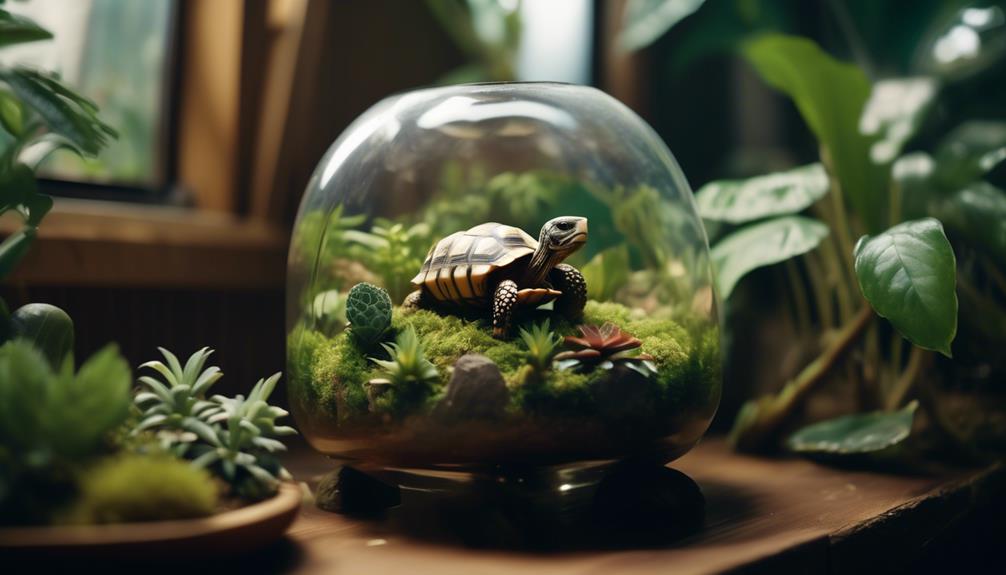
To properly care for Russian Tortoises and understand their behavior, it's important to follow specific guidelines and provide a suitable environment. These tortoises require low maintenance care, but there are some key requirements to keep in mind.
The minimum enclosure size should be 2×4, with a deep substrate for burrowing. They need a dry, warm environment with a humidity level around 60%. The basking area temperature should be 90-95F, while the rest of the enclosure should be in the low 70s Fahrenheit.
Make sure to provide a shallow dish of clean water at all times and a hiding place on the cooler end of the enclosure. It's also crucial to have a full-spectrum fluorescent bulb for UVB rays.
Lastly, it isn't advisable to house Russian Tortoises with other tortoises. Despite their low maintenance care, these tortoises are entertaining, friendly, active, and outgoing.
Small Size and Length
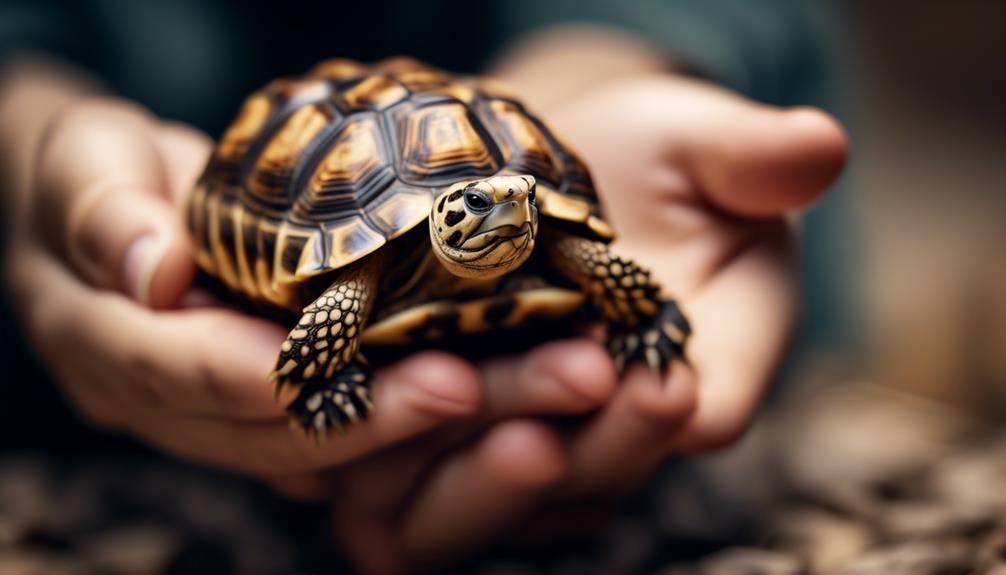
With their compact stature and varying lengths, Russian Tortoises captivate the eye and intrigue the mind. These small, but mighty creatures have a lot to offer. Here are five fascinating facts about their size and length:
- Russian Tortoises are small in size, making them easy to handle and care for.
- Their length can vary, but on average, they measure between 6 and 10 inches.
- Despite their small size, they've a long lifespan of 50 to 100 years.
- These tortoises are terrestrial creatures, preferring to live on land rather than in water.
- They thrive in environments with cold winters and hot summers, and can be found in hilly or rocky areas near vegetation and grass.
With their unique size and length, Russian Tortoises are truly a wonder of nature.
Impressive Lifespan
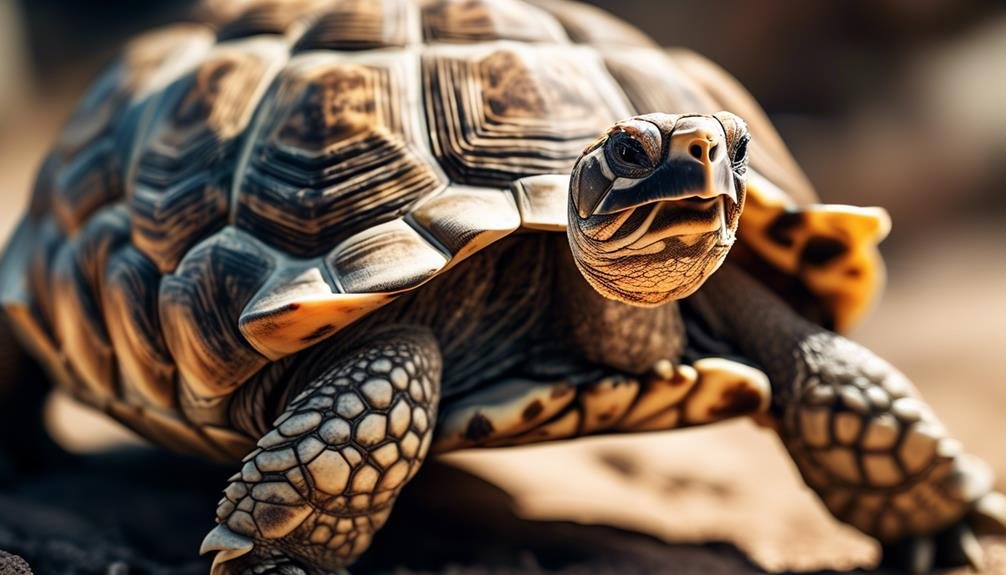
Russian Tortoises may be small in size, but they boast an impressive lifespan of 50 to 100 years. That means if you decide to bring one into your home, you'll be committing to a long-term companion. These tortoises have the potential to be part of your life for several decades, providing you with years of enjoyment and companionship.
With proper care and a suitable environment, they can thrive and live a full, healthy life. It's important to consider the commitment and responsibility that comes with caring for a Russian Tortoise, as they require specialized care and attention.
But if you're willing to put in the effort, you'll be rewarded with a fascinating and long-lived friend.
Terrestrial Habitat Preference
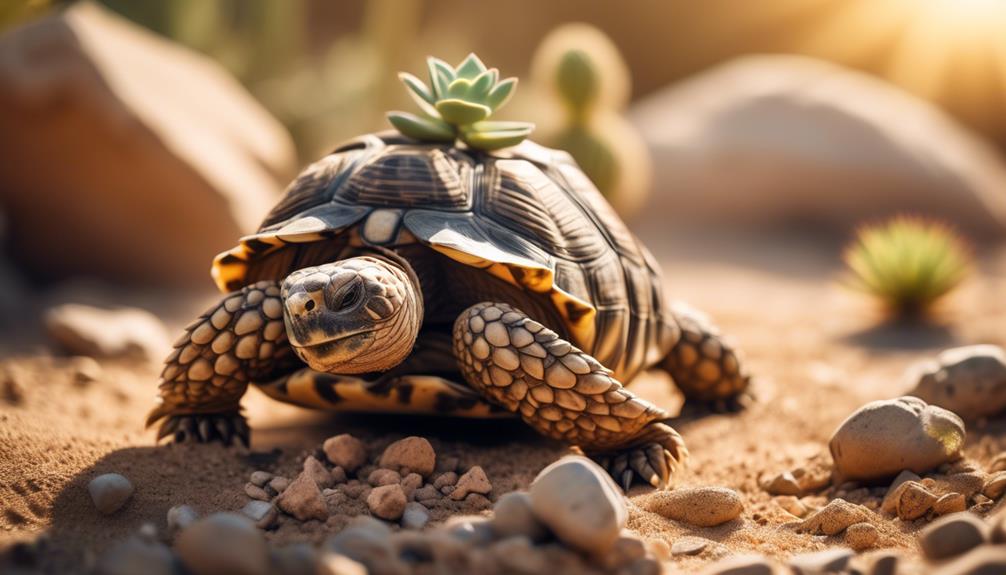
Russian Tortoises have a strong preference for terrestrial habitats found in hilly or rocky areas near vegetation and grass. They thrive in environments with cold winters and hot summers.
Here are five key features of their habitat preference:
- Hilly or rocky areas: Russian Tortoises prefer habitats with natural elevation changes and rocky terrain.
- Vegetation and grass: They seek areas with abundant plant life for feeding and shelter.
- Burrowing and modifying burrows: Russian Tortoises are skilled at burrowing and often modify existing animal burrows for their own use.
- Dry and warm environments: These tortoises require a habitat that provides a dry and warm climate.
- Protection and hiding spots: They prefer habitats that offer hiding places, such as rocks or vegetation, on the cooler end of the enclosure.
Understanding their habitat preference is crucial for providing suitable living conditions for Russian Tortoises in captivity.
Cold Winters and Hot Summers
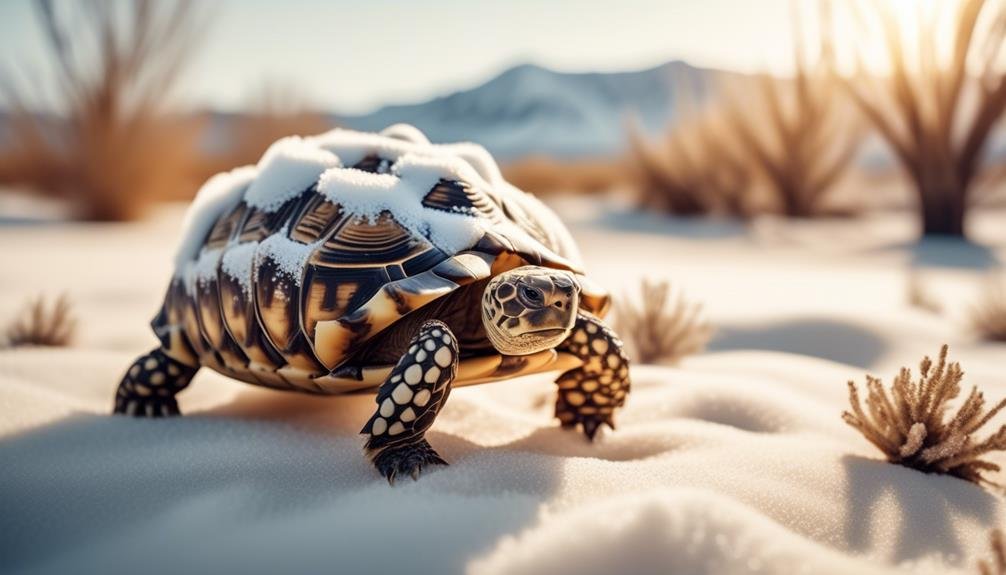
To properly cater to the habitat preferences of Russian Tortoises, it's important to understand their need for cold winters and hot summers. These tortoises are native to dry, desert environments, and they've adapted to thrive in extreme temperatures.
During the winter months, they require cooler temperatures to enter a state of hibernation, which is vital for their overall health and well-being.
On the other hand, during the summer, they need hot temperatures to bask and regulate their body temperature. It's crucial to provide a suitable enclosure that mimics these temperature fluctuations, with a basking area temperature of 90-95 degrees Fahrenheit and the rest of the enclosure in the low 70s.
Hilly or Rocky Areas for Shelter
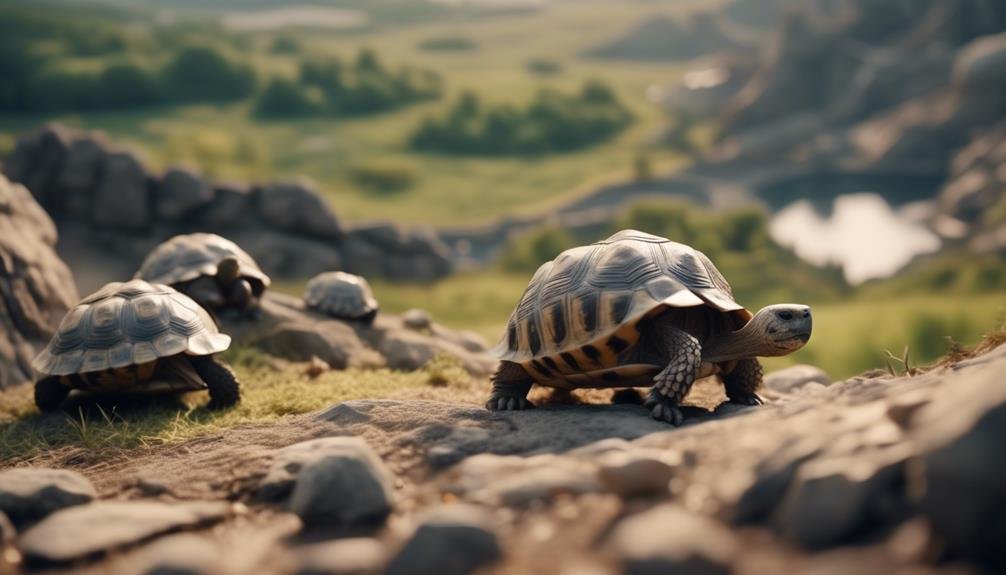
For the shelter needs of Russian Tortoises, they seek out hilly or rocky areas where they can find natural protection. These areas provide them with the necessary cover and security they need to thrive in their habitat.
Here are five reasons why hilly or rocky areas serve as ideal shelters for Russian Tortoises:
- Natural camouflage: The tortoises can blend in with the rocks and terrain, making it harder for predators to spot them.
- Protection from weather: The rocky areas provide natural barriers against harsh weather conditions such as strong winds or extreme temperatures.
- Burrowing opportunities: The rocky terrain offers ample opportunities for the tortoises to dig burrows and create their own secure hideouts.
- Access to food sources: Vegetation and grasses often grow around rocky areas, ensuring that the tortoises have a nearby food source.
- Sunbathing spots: The rocky surfaces retain heat, providing the tortoises with warm spots to bask and regulate their body temperature.
Leafy Greens and Grasses as Diet
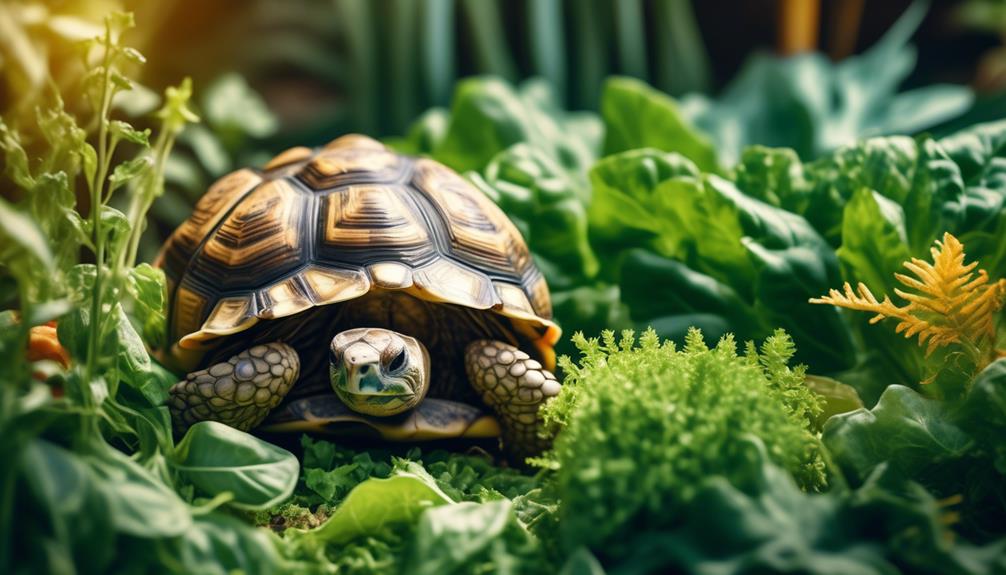
Leafy greens and grasses serve as essential components of the Russian Tortoise's diet, providing them with essential nutrients and fiber. These small reptiles have a low protein, high fiber diet, and leafy greens and grasses help fulfill their dietary needs.
They enjoy feasting on a variety of greens, including dandelion greens, collard greens, and mustard greens. These leafy vegetables aren't only rich in vitamins and minerals but also provide the tortoises with the necessary fiber for digestion.
Along with leafy greens, grasses such as Timothy hay and Bermuda grass are also beneficial for their diet. These grasses offer the tortoises a good source of fiber and entertainment, as they love to graze on them throughout the day.
Providing a diverse range of leafy greens and grasses ensures that the Russian Tortoise maintains a healthy and balanced diet.
Low Protein, High Fiber Diet
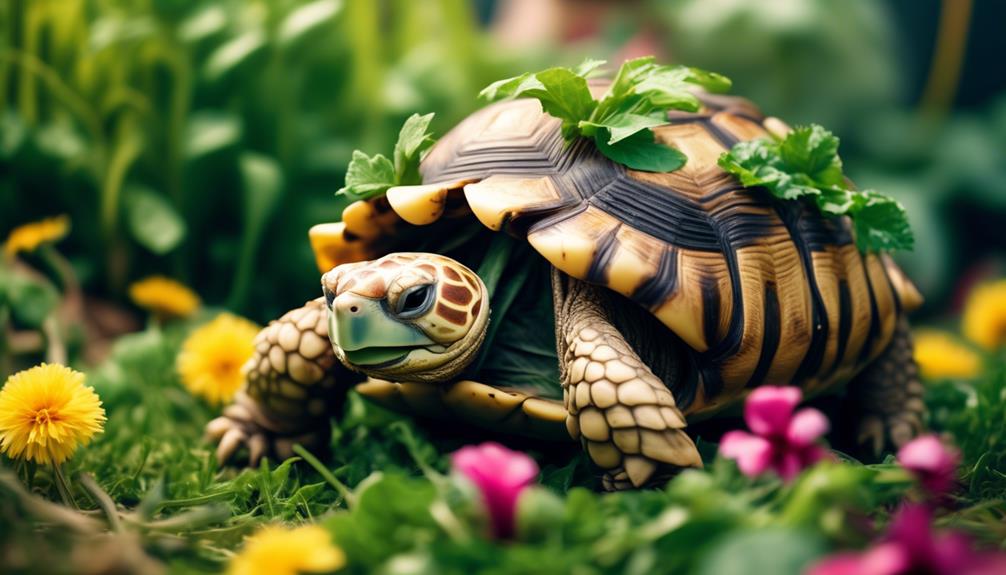
As we shift our focus to the topic of the Russian Tortoise's diet, let's explore the importance of maintaining a low protein, high fiber intake for these fascinating reptiles.
Here are five key reasons why a low protein, high fiber diet is essential for Russian Tortoises:
- Promotes proper digestion and prevents digestive issues
- Helps maintain a healthy weight and prevents obesity
- Supports shell and bone development
- Reduces the risk of kidney and liver problems
- Mimics their natural diet in the wild
Dry, Desert Environments as Native Habitat
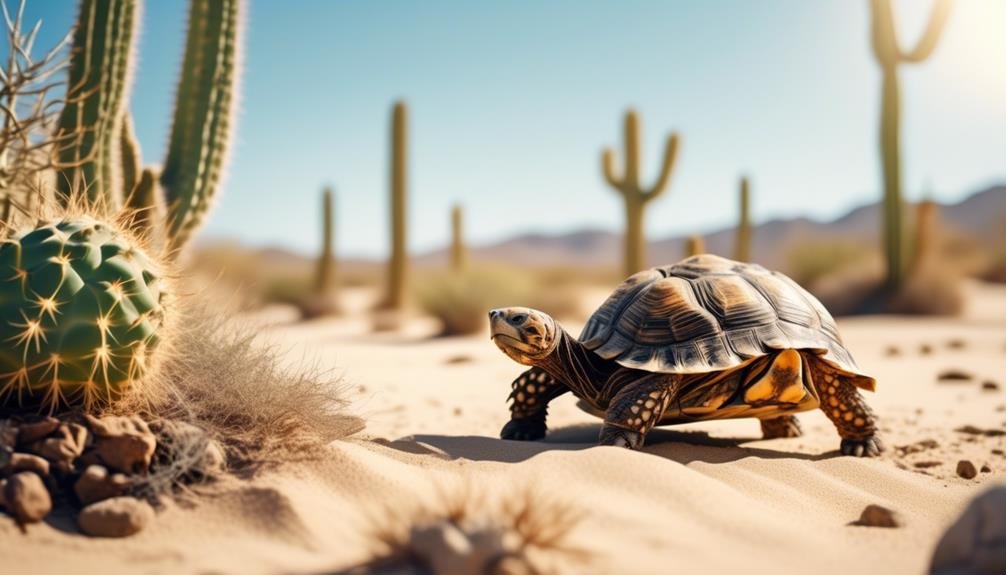
Russian Tortoises thrive in the dry, arid environments of their native habitat. Found in regions such as Iran, Afghanistan, Kazakhstan, Uzbekistan, China, Russia, and Pakistan, these tortoises are well-adapted to the harsh conditions of the desert. They prefer cold winters and hot summers, and are often found in hilly or rocky areas near vegetation and grass.
Russian Tortoises have the ability to burrow and modify animal burrows to create shelter from the extreme temperatures. Their stocky appearance and rounded, oval carapace help protect them from predators and provide insulation. With colors ranging from almost black to bright yellow, these tortoises blend in with their sandy surroundings.
It's fascinating to observe how Russian Tortoises have evolved to thrive in such dry, desert environments.
Stocky Appearance and Unique Features
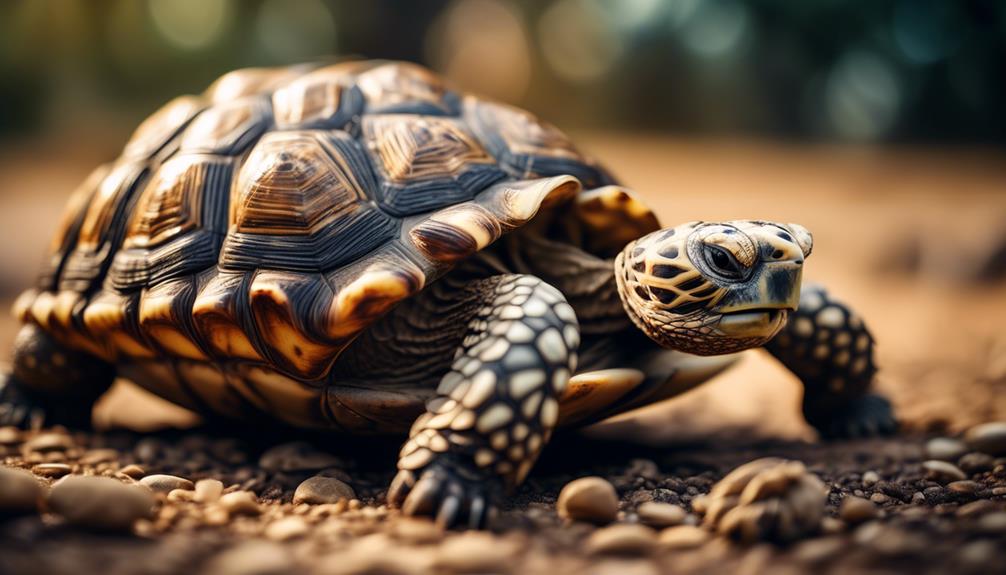
Have you ever wondered what sets Russian Tortoises apart from other species? Well, let me tell you, they've a stocky appearance and unique features that make them truly fascinating.
Here are five things that make them stand out:
- Rounded and oval carapace: Their shell has a distinct shape, which adds to their adorable appearance.
- Rigid plastron without movable hinge: Unlike some other tortoises, Russian Tortoises have a solid bottom shell that doesn't move.
- Four claws on each foot, with a terminal claw on the tail: They've a total of five claws, which is quite unique among tortoises.
- Colors range from almost black to bright yellow, with most being brown to olive: Their color variations make them visually appealing and delightful to observe.
- Stocky build: Russian Tortoises have a compact and muscular body, giving them a robust and sturdy look.
These features contribute to the overall charm and uniqueness of the Russian Tortoise.
Low Maintenance Care and Friendly Behavior
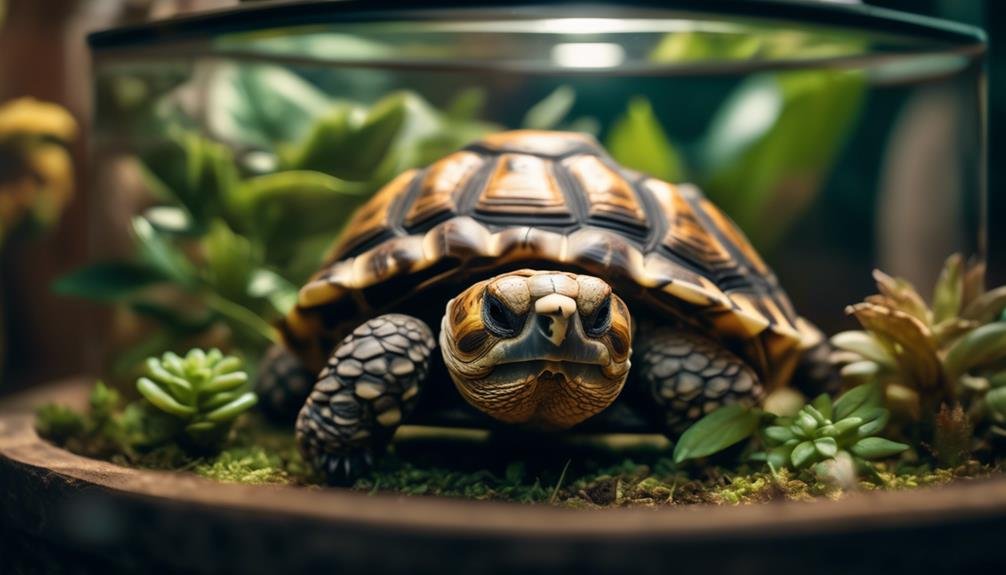
Now let's explore the easy care and friendly nature of Russian Tortoises. These tortoises require low maintenance care, making them a great choice for beginner reptile owners.
To provide a comfortable environment, you'll need a minimum enclosure size of 2×4 with deep substrate for burrowing. Maintain a dry and warm environment with a humidity level of around 60%. The basking area should have a temperature of 90-95F, while the rest of the enclosure should be in the low 70s Fahrenheit. Make sure to provide a shallow dish of clean water at all times and a hiding place on the cooler end of the enclosure.
Additionally, a full-spectrum fluorescent bulb should be used to provide UVB rays. Russian Tortoises aren't advisable to be housed with other tortoises, but they make great companions as they're entertaining, friendly, active, and outgoing.
Frequently Asked Questions
Can the Russian Tortoise Be Kept as a Pet in a Small Apartment?
Yes, the Russian tortoise can be kept as a pet in a small apartment. They are low maintenance, require a minimum enclosure size of 2×4, and prefer a dry, warm environment.
Are Russian Tortoises Prone to Any Specific Health Issues or Diseases?
Russian tortoises are not prone to any specific health issues or diseases. However, it is important to provide them with a proper diet, suitable enclosure, and regular veterinary check-ups to ensure their overall well-being.
How Often Should the Substrate in the Enclosure Be Changed?
You should change the substrate in your enclosure for a Russian Tortoise every few months. This helps maintain cleanliness and prevents the buildup of waste and bacteria that could harm your tortoise's health.
Can Russian Tortoises Swim?
Yes, Russian tortoises can swim. They are capable swimmers, but it's important to provide a shallow dish of clean water for them to safely enjoy.
Are Russian Tortoises Social Animals and Do They Enjoy Human Interaction?
Russian tortoises are not social animals, but they can tolerate human interaction. They enjoy exploring their surroundings and may interact with you. Remember to provide a suitable environment and respect their natural behavior.
Are Yellow-Footed Tortoises Similar to Russian Tortoises in Their Care and Habitat Needs?
When it comes to yellowfooted tortoise information and facts, it’s important to note that while both yellow-footed tortoises and Russian tortoises share some similarities in their care and habitat needs, there are also differences. Yellow-footed tortoises, native to South America, require a more humid environment compared to the arid habitat preferred by Russian tortoises.
Conclusion
In conclusion, the Russian Tortoise is a captivating and fascinating reptile that can live for an impressive 50-100 years. With their unique characteristics and stocky appearance, they make for entertaining and friendly pets.
Their low protein, high fiber diet and preference for dry, warm environments make them relatively low maintenance to care for.
So, if you're looking for an active and long-lived companion, the Russian Tortoise is the perfect choice.

